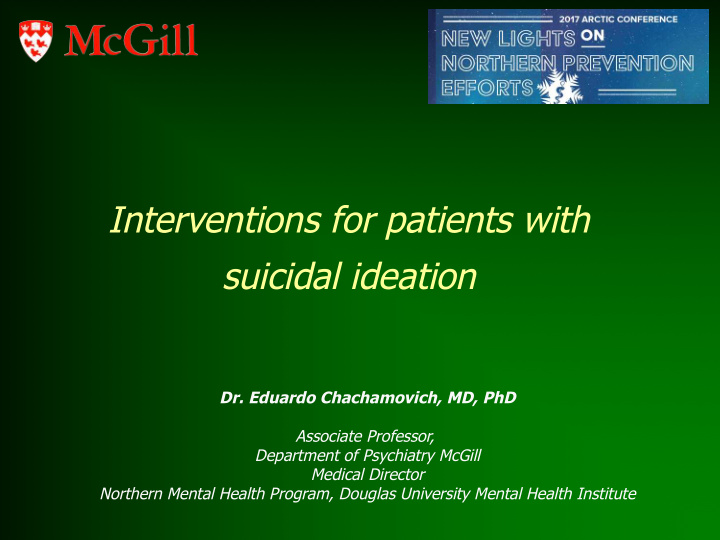



Interventions for patients with suicidal ideation Dr. Eduardo Chachamovich, MD, PhD Associate Professor, Department of Psychiatry McGill Medical Director Northern Mental Health Program, Douglas University Mental Health Institute
Overview 1. Suicidality: Continuum? 2. Risk factors, protective factors 3. Assessment of suicidality and its limitations 4. The Northern Mental Health Program at DMHUI • Telehealth • Postvention
Disclosure Research funded by:
Deaths by suicide in Nunauvt (1982-2008):
Suicide Ideation and Attempts: Have you ever in your life seriously thought of committing suicide? Yes 687 (48.5%) Women / Men 2:1 Have you ever in your life attempted suicide? Yes 434 (35.9%) Women / Men 2:1
Continuum ? Healthy Ideation Attempts Completion Questionable: ü Seem to be true for a subgroup of the population only (heterogeneous pathways) ü Low prediction (only a fraction of the former will move on to the next) 30% from SI to SA, and 32% from SA to action, 6% from SA to completion ü Different risk factors for each step
Mental Illness, 2012, vol 4:e15
Nunavut Suicide Follow-Back Study Latent Class Analysis - Mplus Group I – Mood + SA Group II – Childhood abuse + legal problems Group III – Impulsivity + aggressive beh.
What does it mean in the clinical practice for all of us ? ü Suicide is multifactorial and has multiple pathways ü Healthcare professionals have more impact on Group I (Mood + SA) ü Social + structural interventions have more impact on Group II (childhood adversities + legal problems) ü Healthcare + social can have an impact on Group III (impulsivity) Emotional consequences of all involved
Qaujivallianiq inuusirijauvalauqtunik ‘ Learning from lives that have been lived ’
Individual-level risk factors: Chachamovich et al, 2015
Psychiatric diagnoses: Chachamovich et al, 2015
Individual-level risk factors: First degree relative suicide p<0.001 Chachamovich et al, 2015
How to assess severity of Suicidal Risk in the clinical practice? 1. Standardized scales (Columbia, Suicidal Intent Scale, Tool for Assessment of Suicidal Risk etc). Designed for general population, and for research purposes mainly Low predictive value, therefore low clinical value Not routinely used in clinical practice Not validated in Indigenous contexts either
Assessment of Suicide Risk
Suicide risk assessment ü Collateral information (family, partner, team) ü Identify psychiatric signs and symptoms ü Past suicidal behavior (OR 38) ü Past treatment history – compliance, alliance ? ü Family history ü Current psychosocial stressors – proximal factors ü Current suicidal ideation ü PROTECTIVE FACTORS
Protective factors: ü Responsibility to others ü Personal, cultural or religious beliefs that discourage suicide ü Reality testing ability ü Positive coping skills (other strategies than suicide) ü Social support ü Hope for the future ü Self-efficacy ü Fear of social disapproval ü Plans for the near future CAMH, 2015
Challenges: 1. Different paths to suicidality 2. Lack of validated tools 3. Limitations as clinicians to manage suicidality 4. Management of crisis model – event and not trajectory “Goal is absence of ACUTE risk”
Northern Mental Health Program ü Mandate (9 James Bay Cree + 14 Inuit in Nunavik) Brief history ü Team composition ü Visits, OPD, tele-health, training, court orders ü Support to GPs/nurses in the communities (phone, email, TH) ü Training of residents, medical students ü Research + Support to development of resources locally ü
Nakurmik !
Recommend
More recommend